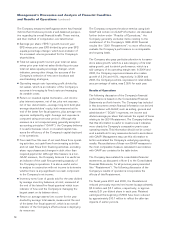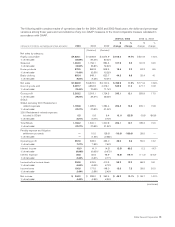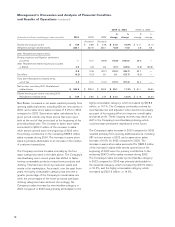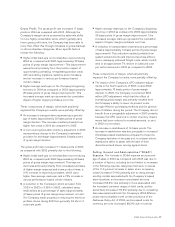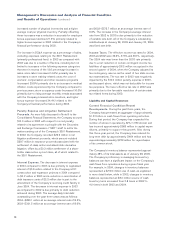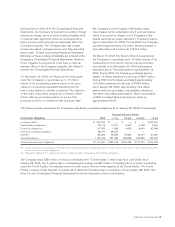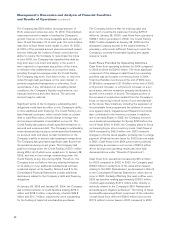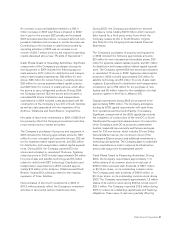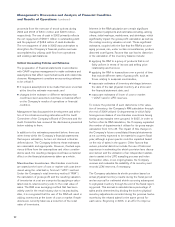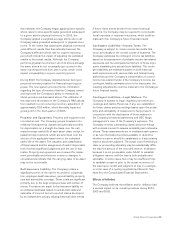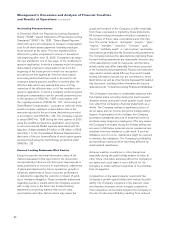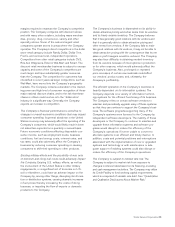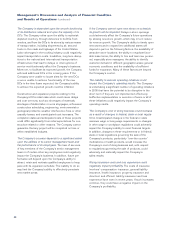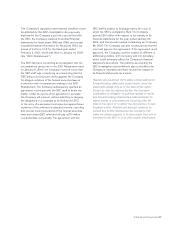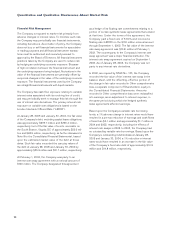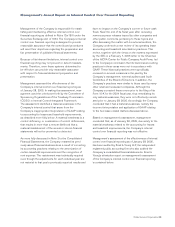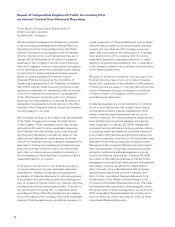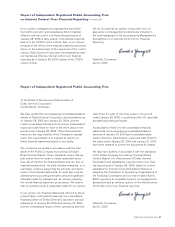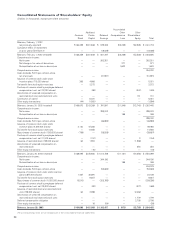Dollar General 2004 Annual Report Download - page 26
Download and view the complete annual report
Please find page 26 of the 2004 Dollar General annual report below. You can navigate through the pages in the report by either clicking on the pages listed below, or by using the keyword search tool below to find specific information within the annual report.24
Management’s Discussion and Analysis of Financial Condition
and Results of Operations (continued)
Accounting Pronouncements
In December 2004, the Financial Accounting Standards
Board (“FASB”) issued Statement of Financial Accounting
Standards (“SFAS”) No. 123R, “Share-Based Payment,”
which will require all companies to measure compensation
cost for all share-based payments (including employee
stock options) at fair value. This new standard will be
effective for public companies for interim or annual peri-
ods beginning after June 15, 2005. Companies can adopt
the new standard in one of two ways: (i) the modified pro-
spective application, in which a company would recognize
share-based employee compensation cost from the
beginning of the fiscal period in which the recognition
provisions are first applied as if the fair-value-based
accounting method had been used to account for all
employee awards granted, modified or settled after the
effective date and to any awards that were not fully
vested as of the effective date; or (ii) the modified retro-
spective application, in which a company would recognize
employee compensation cost for periods presented prior
to the adoption of SFAS No. 123R in accordance with
the original provisions of SFAS No. 123, “Accounting for
Stock-Based Compensation,” pursuant to which an entity
would recognize employee compensation cost in the
amounts reported in the pro forma disclosures provided
in accordance with SFAS No. 123. The Company expects
to adopt SFAS No. 123R during the third quarter of 2005
using the modified prospective application, and expects
to incur incremental SG&A expense associated with the
adoption of approximately $4 million to $8 million in 2005.
See Note 1 to the Consolidated Financial Statements for
disclosure of the pro forma effects of stock option grants
as determined using the methodology prescribed under
SFAS No. 123.
Forward Looking Statements/Risk Factors
Except for specific historical information, many of the
matters discussed in this report and in the documents
incorporated by reference into this report may express or
imply projections of revenues or expenditures, statements
of plans and objectives for future operations, growth or
initiatives, statements of future economic performance
or statements regarding the outcome or impact of pend-
ing or threatened litigation. These and similar statements
regarding events or results which the Company expects
will or may occur in the future are forward-looking
statements concerning matters that involve risks,
uncertainties and other factors which may cause the
actual performance of the Company to differ materially
from those expressed or implied by these statements.
All forward-looking information should be evaluated in
the context of these risks, uncertainties and other fac-
tors. The words “believe,” “anticipate,” “project,” “plan,”
“expect,” “estimate,” “objective,” “forecast,” “goal,”
“intend,” “will likely result” or “will continue” and similar
expressions generally identify forward-looking statements.
The Company believes the assumptions underlying these
forward-looking statements are reasonable; however, any
of the assumptions could be inaccurate, and therefore,
actual results may differ materially from those projected
in the forward-looking statements. Factors and risks that
may result in actual results differing from such forward-
looking information include, but are not limited to, those
listed below, as well as other factors discussed throughout
this document, including without limitation the factors
described under “Critical Accounting Policies and Estimates.”
TheCompany’sbusinessismoderatelyseasonalwith
thehighestsalesoccurringduringthefourthquarter.
Adverseeventsduringthefourthquartercould,there-
fore,affecttheCompany’sfinancialstatementsasa
whole. The Company realizes a significant portion of
its net sales and net income during the holiday selling
season. In anticipation of the holidays, the Company
purchases substantial amounts of seasonal inventory
and hires many temporary employees. If for any reason
the Company’s net sales during the holiday selling sea-
son were to fall below seasonal norms, a seasonal mer-
chandise inventory imbalance could result. If such an
imbalance were to occur, markdowns might be required
to minimize this imbalance. The Company’s profitability
and operating results could be adversely affected by
unanticipated markdowns.
Adverse weather conditions or other disruptions,
especially during the peak holiday season but also at
other times, could also adversely affect the Company’s
net sales and could make it more difficult for the
Company to obtain sufficient quantities of merchandise
from its suppliers.
Competitionintheretailindustrycouldlimitthe
Company’sgrowthopportunitiesandreduceitsprofit-
ability. The Company competes in the discount retail
merchandise business, which is highly competitive.
This competitive environment subjects the Company to
the risk of reduced profitability resulting from reduced


